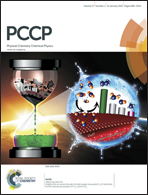Assignment of the 13C NMR spectrum by correlation to dipolar coupled proton-pairs and estimation of order parameters of a thiophene based liquid crystal
Abstract
Materials with widely varying molecular topologies and exhibiting liquid crystalline properties have attracted considerable attention in recent years. 13C NMR spectroscopy is a convenient method for studying such novel systems. In this approach the assignment of the spectrum is the first step which is a non-trivial problem. Towards this end, we propose here a method that enables the carbon skeleton of the different sub-units of the molecule to be traced unambiguously. The proposed method uses a heteronuclear correlation experiment to detect pairs of nearby carbons with attached protons in the liquid crystalline core through correlation of the carbon chemical shifts to the double-quantum coherences of protons generated through the dipolar coupling between them. Supplemented by experiments that identify non-protonated carbons, the method leads to a complete assignment of the spectrum. We initially apply this method for assigning the 13C spectrum of the liquid crystal 4-n-pentyl-4′-cyanobiphenyl oriented in the magnetic field. We then utilize the method to assign the aromatic carbon signals of a thiophene based liquid crystal thereby enabling the local order-parameters of the molecule to be estimated and the mutual orientation of the different sub-units to be obtained.


 Please wait while we load your content...
Please wait while we load your content...